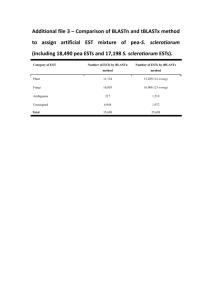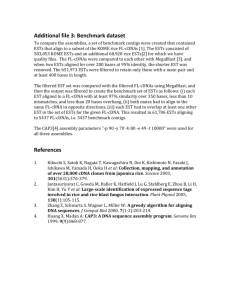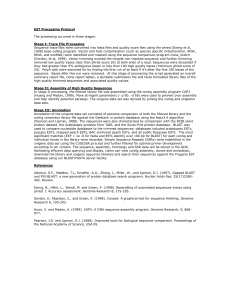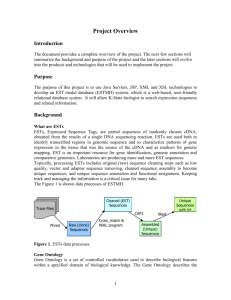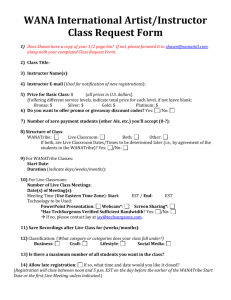TBestDB-29Sep2005 - Université de Montréal
advertisement
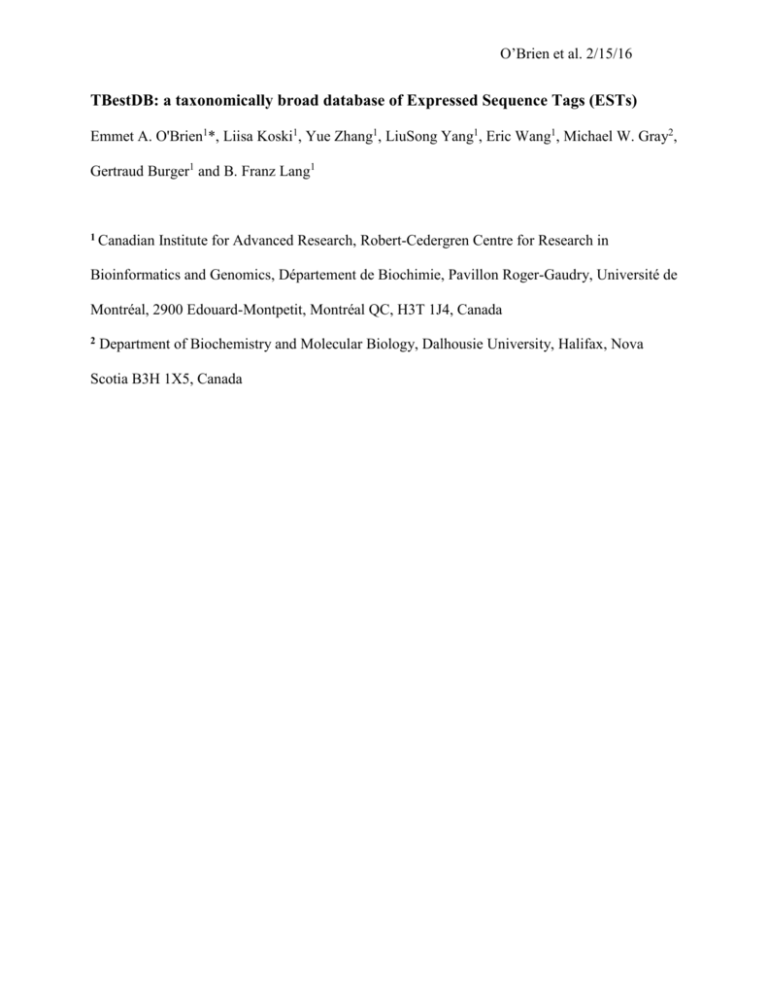
O’Brien et al. 2/15/16 TBestDB: a taxonomically broad database of Expressed Sequence Tags (ESTs) Emmet A. O'Brien1*, Liisa Koski1, Yue Zhang1, LiuSong Yang1, Eric Wang1, Michael W. Gray2, Gertraud Burger1 and B. Franz Lang1 1 Canadian Institute for Advanced Research, Robert-Cedergren Centre for Research in Bioinformatics and Genomics, Département de Biochimie, Pavillon Roger-Gaudry, Université de Montréal, 2900 Edouard-Montpetit, Montréal QC, H3T 1J4, Canada 2 Department of Biochemistry and Molecular Biology, Dalhousie University, Halifax, Nova Scotia B3H 1X5, Canada ABSTRACT Background: The wide range of eukaryotic evolutionary variation outside of the well-studied kingdoms of animals, plants and fungi, commonly referred to as protists, is comparatively underrepresented in sequence databases. Most EST or genomic sequencing projects in the protist domain tend to have a very specialized focus, for example on specific organisms pathogenic to humans. In contrast, the Protist EST Program, a collaboration among six Canadian laboratories, has generated ESTs from a taxonomically broad range of eukaryotes, which are made available in the database TBestDB. Currently, TBestDB contains ~370,000 ESTs from 16 taxa; we estimate this number will rise to >50 by July 2006. Description: The TBestDB database contains EST sequences, experimental information, clustered consensus sequences, gene annotations and metabolic pathway predictions from a taxonomically broad range of poorly studied, mainly unicellular eukaryotes. EST sequences are read from trace files up to a minimum quality cut-off, vector and linker sequence is masked, and the ESTs are clustered using phrap. The resulting consensus sequences are automatically annotated by the AutoFACT program. The datasets are automatically checked for clustering errors due to chimerism and potential crosscontamination between organisms, and suspect data are removed from or flagged in the database. Data deposited in TBestDB by individual users can be restricted to those users for a limited period. 2 Conclusion: With this first report on TBestDB, we open the database to the research community for automatic processing, annotation, interspecies comparisons and GenBank submission of EST data generated in individual laboratories. *Contact: eobrien@bch.umontreal.ca 3 BACKGROUND Much of the evolutionary diversity and biochemical versatility of the domain Eucarya is contained outside the kingdoms of animals, plants and fungi, in a highly diverse assemblage of poorly studied, mostly unicellular eukaryotes commonly referred to as protists (1-3). Because the early eukaryotic world must have been exclusively unicellular, protists are key to understanding the origin and evolution of multicellular eukaryotes. As we know today, close unicellular relatives of the multicellular animals, fungi and land plants are, respectively, choanoflagellates plus Ichthyosporea (4,5), chytridiomycetes plus nucleariids ((6-9); Steenkamp, Baldauf and Lang, unpublished), and charophyte algae (10,11). Unfortunately, very few protist genome projects are underway and protist nuclear genomics data are often limited to one or a few standard genes. An effective way of alleviating this shortcoming is to generate ESTs (Expressed Sequence Tags) from cDNA libraries. This technique is fast and cost-effective, and provides a robust approximation of the expressed genetic component of a given organism. The Protist EST Program (PEP) is a collaboration among six Canadian laboratories with the objective of characterising the expressed portion of the nuclear genome of a large number (currently >50) of different protist species. Most other protist EST and genome projects focus on pathogenic organisms (e.g. ApiEST-DB (12), CryptoDB (13), Full-Malaria (14), PlasmoDB (15), TcruziDB (16), ToxoDB (17) and the protist data contained in GeneDB (18)). The few exceptions such as the Diatom EST Database (19), dictyBase (20) and the Porphyra yezoensis EST index (21) tend to have a very specialized focus. PEP, in contrast, aims to survey a taxonomically broad collection of protists and other poorly studied eukaryotic groups (Table 1). Since the inception of the PEP project, a total of about 370,000 EST sequences have been 4 generated, from 53 organisms, of which data from 16 are publicly available (status 1 August 2005), and curated in the database TBestDB, which is described in this report. CONSTRUCTION AND CONTENT Information in TBestDB that is publicly accessible at the time of writing is compiled in Table 1. Data include individual EST sequences, consensus sequences and clustering information, conceptual translations, functional annotations drawn from three different sources, as well as metabolic pathway predictions. In addition, the database contains experimental information on cDNA libraries and information on data quality and project status. The EST processing pipeline includes three primary steps (Fig. 1), starting with the download of sequence submitted by the PEP member laboratories. Annotation is then followed by post-processing steps to detect potential contamination and chimerism. Sequence clustering EST data are accepted as tracefiles in .scf or .abi format. Incoming tracefiles are processed using the phred/phrap package (22), which reads each tracefile, converts it to a sequence file with associated quality assessments for each residue, removes both vector and linker sequences and finally assembles the ESTs into clusters to generate consensus sequences. It should be noted that there is an observed difficulty with phrap in clustering datasets beyond a certain number of readings (starting between 5000 and 10,000 in our datasets), manifesting as a failure to generate some small number, usually <5%, of expected clusters. We 5 have addressed this difficulty by recursively running phrap on the set of unclustered sequences until no new clustering is found. Statistical breakdown Once clustering is completed, various statistics are calculated to facilitate the management of ongoing EST projects. Sequence quality is assessed by monitoring maximal and average reading length after quality clipping, and clone insert sizes before and after vector clipping are evaluated globally and by library. The overall progress of the project can be assessed on the basis of the distribution and growth of cluster size, and the evolution of redundancy of individual or multiple libraries for a given organism can be monitored, allowing rapid decisions concerning productive directions for further sequencing. Annotation TBestDB conducts three kinds of annotation procedures for consensus sequences derived from clustered ESTs. (i) AutoFACT (23) provides the most sophisticated annotations. Using local BLAST comparisons (24), AutoFACT gathers classification information following a hierarchical system, from a collection of seven specialized databases (Table 2). Because not all descriptions from top BLAST hits contain biologically meaningful information, AutoFACT adopts an ‘uninformative rule’ to identify the highest scoring BLAST hit that provides a meaningful annotation. In this way, AutoFACT generates ~50% more functionally informative annotations than a top-BLAST-hit approach. Annotations provided by AutoFACT are of high quality, but the process of generating them is time-consuming (it takes 3-5 days to annotate 5000 sequences on a double-processor PC) due to the need for multiple BLAST searches. (ii) The Rapid Annotation 6 procedure was designed to allow quick initial surveys of incoming data. Here, annotations are assigned by searching for sequence similarity with deduced nucleus-encoded proteomes from selected organisms (Arabidopsis thaliana, Ustilago maydis, Neurospora crassa, Homo sapiens, Rickettsia prowazeki and Magnetospirillum magnetotacticum), with deduced mitochondrionencoded proteins of Reclinomonas americana, and with collections of representative large and small subunit rRNAs. Using this procedure, information about ubiquitous proteins and contamination of cDNA libraries with mitochondrial or rRNA sequences can quickly be made available to TBestDB users. Rapid Annotation is run as part of the processing and clustering of each new EST data set. With this system a set of 5000 clusters can be annotated in ~2 hours, which allows for new datasets, typically containing 500-1000 EST sequences, to be clustered and the entire dataset to be reannotated within one working day. (iii) Finally, to detect similarities with as-yet-unrecognised hypothetical proteins in published DNA sequences, TBLASTX is run against a local copy of NCBI’s non-redundant database and the top hit is shown. The time requirement for this step is quite high, approximately 10 minutes per sequence on a 16-CPU cluster. In addition to the above-mentioned automatic annotations, expert manual annotations are available in some cases, when provided by the submitter of the sequences. Should all the analyses fail to identify the function of a consensus sequence, it is annotated as ‘unknown function’. The above annotation procedures are not only executed when new EST data are submitted, but are rerun regularly. In consequence, automatically assigned names may change as the reference databases are updated, and for this reason any reference to data in TBestDB should use TBestDB’s internal cluster IDs in addition to the annotations provided. 7 Metabolic pathway prediction AutoFACT annotations are used to build a Pathway Genome Database (25) for each individual organism. On this basis, annotated sequences can be mapped to metabolic pathways available in MetaCyc (26). This allows users to determine which components of a given pathways are present in, or still missing from, the sequenced part of an EST library and, ultimately, to assess the biological versatility of the organisms studied. Contamination management In large sequencing projects, some level of contamination between datasets or from external sources is in practice unavoidable. Sources of contamination include food organisms (bacteria on which many of the organisms documented in TBestDB are grown), symbionts, and human error during culturing, cloning and sequencing. In TBestDB we have implemented an automated system for identification of potential cross-project contamination, in order to mitigate this problem as far as possible. Each consensus sequence in TBestDB (query cluster) is searched against every other organism in the database (subject clusters) using BLASTN. Potential contaminants are identified at a threshold of ≥ 97% sequence identity over at least 50 nucleotides. This threshold also detects rRNA sequences and well known highly conserved proteins such as actin and ubiquitin, which are excluded from consideration as contaminants. We automatically remove from the database any query cluster that is found to match a subject cluster containing at least 3 times as many ESTs. Less clear-cut cases of potential contaminants are flagged and the source laboratory is asked to examine the flagged sequences and determine whether they should remain in TBestDB. 8 All of the ESTs belonging to contaminating clusters are moved into a separate database table, where they are used in further rounds of contamination checking. This procedure is necessary so that curation of different organisms at different times can identify possible common sources of contamination, such as commercial library services shared by several users. Identification of chimerism Submitted datasets occasionally include chimeric ESTs (i.e., ESTs containing sequence from two distinct cDNAs), which causes problems during clustering. The identification of such ESTs is not straightforward, but we have implemented automatic tests that find many such cases of chimerism. The simplest test is a search for misplaced polyA tracts in the EST sequence. A correctly assembled consensus sequence for a complete cDNA should have a single 3’-terminal polyA region. In practice, at least 10 A or T residues (depending on the direction of sequencing) are sufficient to identify the 3’ end of a transcript. Any sequence containing an apparent polyA or reverse-complemented polyA tail at both ends, or an internal polyA or polyT tract, is flagged as potentially chimeric. Chimerism in EST sequences without polyA tails is harder to detect. Our current practice is to identify these ESTs by the effects they have on the clustering process. Chimeric ESTs are expected to show matches with different sets of sequences. Therefore clusters containing chimerism should consist of two distinct ‘blocks’ of ESTs, usually linked by only a single sequence where the fusion occurs (Fig. 2). (This situation is also occasionally encountered when one of the ESTs in a large cluster contains an unexcised intron.) This pattern can be automatically identified by counting the number of ESTs at every position along the cluster and 9 looking for abrupt changes in that number over a short distance. Obviously, this pattern can only be identified in clusters with sufficient coverage – in our experience, clusters containing 10 or more ESTs. In all cases, clusters identified as potentially chimeric are flagged in the database and the decision whether or not to remove chimeric ESTs is left to the submitter of the data. Implementation The TBestDB database is implemented in PostgreSQL 7.4.1 with a web interface written in PHP v4.3.8. The graphics on the cluster pages are generated using the GD module, version 2.0.25. The pipeline is constructed using Perl (5.8.0) scripts to manage the data, call the programs from the phred suite, and insert the results into the database. BLAST searches for sequence annotation by AutoFact and TBLASTX searches are run on a separate multi-CPU server. All other procedures are executed on PCs with two 2.4GHz or 2.8GHz Intel Xeon CPUs. UTILITY AND DISCUSSION Data access and presentation When users log in to TBestDB they are presented with a list of organisms currently available in the database. Each organism name on the main page links to the organism’s principal data page (Fig. 3). Access permissions to this data page are determined by the individual user, allowing data to remain private for up to six months so that those who generate a dataset have time to analyse it before it becomes public. As seen in Fig. 3, the organism’s principal data page contains basic library and read information and links to pages compiling experimental information and the various statistics detailed above. To maintain data currency, most statistics 10 are calculated dynamically on access. This page also shows all annotated clusters, with options of ordering clusters in several ways and searching the various annotation fields for clusters of interest. The cluster ID links to a page containing detailed information related to that cluster, including download functionality for DNA and deduced protein sequences (Fig. 4). The TBestDB main page also links to a set of Pathway Genome DataBases (25) that have been built for each organism for which annotated data are available in TBestDB. Via the pathway viewer (25) seamlessly accessible from within TBestDB, users can inspect specific pathways, enzymatic reactions, or compounds of interest as well as visualize which enzymes and pathways are present within the organism under study or shared with other organisms. For pathway comparisons, published proteomes from Escherichia coli strain K-12, Rickettsia prowazekii and Saccharomyces cerevisiae have been included in TBestDB. It is straightforward to perform BLAST searches against all or selected data included in TBestDB to which a user has access. The corresponding query sequences can be uploaded or copy-pasted into a window, and BLAST search functionality is achieved via a link to the webbased workbench AnaBench (27), developed in-house. Another valuable feature of TBestDB at a more practical level is that control of access to data is adaptable to meet the needs of individual users. User accounts can be defined to have read access to any possible subset of the data within TBestDB. This feature allows users to restrict access to their data for some specified period of time prior to release. Utility: examples The clustering process implemented in TBestDB features a high level of discrimination, capable of distinguishing closely related homologs. Data from the amoebozoan protist Acanthamoeba 11 castellanii provide suitable examples. Clusters ACL00004208 (containing 32 ESTs) and ACL00004800 (42 ESTs) represent two variants of ribosomal protein S3A, differing at only three nucleotide positions within the coding region. Similarly, five variant actin sequences are correctly distinguished in this organism (clusters ACL00003090, ACL00003089, ACL00004196, ACL00004782 and ACL00004755). Of the 1125 nucleotide positions encoding 375 amino acids in actin, only 52 are heterogeneous in these five sequences, and all except one of the substitutions are silent. The clustering process is also able to discriminate among clusters that are identical within the coding region but differ within the 3’-terminal untranslated region, either because the different clusters represent distinct alleles, or because of variation in the location of the polyadenylation site in transcripts of the same gene. In cases where consensus EST cluster sequences have counterparts in partial A. castellanii genomic data (28), the match between EST and genomic sequence is almost always 100%, so that the comparison allows ready recognition of introns. For example, ACL00000330 (53 ESTs) encodes a complete ORF for ribosomal protein S3, and comparison with genomic sequence finds an exact match and precisely identifies two GT…AG spliceosomal introns in the latter sequence. Notably, the datasets collected in TBestDB allow analyses to be conducted on a number of different scales. On the one hand, these data have provided unprecedented insights into the biology of specific protists, which have not previously been analysed at the molecular level in either substantial depth or substantial breadth. For example, the question of residual plastid functions in the non-photosynthetic green algae Prototheca wickerhamii and Helicosporidium sp. has successfully been addressed by surveying nucleus-encoded plastid-targeted proteins (29,30). On a broader scale, the capacity to carry out analyses across a consistently populated and 12 annotated set of taxonomically diverse data allows for rigorous exploration of fundamental biological questions. These questions include the origins of photosynthesis among eukaryotes (31), the extent of lateral gene transfer within various eukaryotic lineages (Watkins, R.F. and Gray, M.W, submitted for publication) and the basal resolution of the eukaryotic tree (32). In sum, TBestDB provides a powerful and flexible resource for clustering, annotation and distribution of EST data, which facilitates in-depth analyses of the genetic and biochemical complexity of individual eukaryotic species, systematic comparisons among taxa, and global phylogenetic analyses of eukaryotes. Outlook In the future, we plan to add more publicly available data to TBestDB, including EST data from representatives of highly sampled eukaryotes such as vertebrate animals, vascular plants and fungi. AVAILABILITY For instructions on submission to TBestDB, contact tbestdb@bch.umontreal.ca. The database can be queried at [http://amoebidia.bcm.umontreal.ca/tbestdb/searches/login.php] . AUTHOR CONTRIBUTIONS EAO designed the database, interface and procedures, oversaw its implementation, and drafted the manuscript. LK designed and implemented AutoFACT and developed the contamination 13 management procedure, and helped in the preparation of the manuscript. YZ carried out population and curation of the database. LY implemented the TBestDB interface. EW wrote the scripts used in database population and in initial identification of potential contaminants. MWG headed the PEP project, and along with GB and BFL suggested many of the features implemented in TBestdb; MWG, GB and BFL also helped in preparation of the manuscript. ACKNOWLEDGEMENTS The authors would like to thank Sebastien Letort for development of graphics, Sandrine Fraissard for work on detection of chimerism, Maria Yu and Sabrina Rodriguez for their contributions to the development of the TBestDB interface, and Allan Sun and David To for systems administration. Work in the authors' laboratories is supported by operating and equipment funds from Genome Canada, Génome Québec, Genome Atlantic, the Atlantic Canada Opportunities Agency (Atlantic Innovation Fund), and the Canadian Institutes of Health Research (CIHR). The Program in Evolutionary Biology of the Canadian Institute for Advanced Research (CIAR) is acknowledged for interaction, travel and salary support to GB, BFL, and MWG. MWG and BFL are also grateful to the Canada Research Chairs Program and Canadian Foundation for Innovation (CFI) for salary and equipment support. We also acknowledge access to the bioinformatics cluster Goldorak of the Bioinformatics Network of Quebec (BioneQ), which is funded by Genome Québec and housed at the Université de Montréal. 14 REFERENCES 1. 2. 3. 4. 5. 6. 7. 8. 9. 10. 11. 12. 13. 14. 15. 16. 17. Patterson, D.J. and Sogin, M.L. (1992) Eukaryote origins and protistan diversity. In Hartman, H. and Matsuno, K. (eds.), The Origin and Evolution of the Cell. World Scientific, Singapore, pp. 13-46. Gray, M.W., Burger, G. and Lang, B.F. (1999) Mitochondrial evolution. Science, 283, 1476-1481. Gray, M.W., Lang, B.F. and Burger, G. (2004) Mitochondria of protists. Annu Rev Genet, 38, 477-524. Wainright, P.O., Hinkle, G., Sogin, M.L. and Stickel, S.K. (1993) Monophyletic origins of the metazoa: an evolutionary link with fungi. Science, 260, 340-342. Lang, B.F., O'Kelly, C., Nerad, T., Gray, M.W. and Burger, G. (2002) The closest unicellular relatives of animals. Curr Biol, 12, 1773-1778. Leigh, J., Seif, E., Rodriguez, N., Jacob, Y. and Lang, B.F. (2003) Fungal evolution meets fungal genomics. In Arora, D. (ed.), Handbook of Fungal Biotechnology. 2nd ed. Marcel Dekker Inc., New York, pp. 145-161. Barr, D.S. (1980) An outline for the reclassification of the Chytridiales, and for a new order, the Spizellomycetales. Can J Biochem, 58, 2380-2394. Bullerwell, C.E., Forget, L. and Lang, B.F. (2003) Evolution of monoblepharidalean fungi based on complete mitochondrial genome sequences. Nucleic Acids Res, 31, 16141623. James, T.Y., Porter, D., Leander, C.A., Vilgalys, R. and Longcore, J.E. (2000) Molecular phylogenetics of the Chytridiomycota supports the utility of ultrastructural data in chytrid systematics. Can J Bot, 78, 226-350. Karol, K.G., McCourt, R.M., Cimino, M.T. and Delwiche, C.F. (2001) The closest living relatives of land plants. Science, 294, 2351-2353. Qiu, Y.L. and Palmer, J.D. (1999) Phylogeny of early land plants: insights from genes and genomes. Trends Plant Sci, 4, 26-30. Li, L., Crabtree, J., Fischer S., Pinney D., Stoeckert C.J. Jr, Sibley L.D. and Roos D.S.. (2004) ApiEST-DB: analyzing clustered EST data of the apicomplexan parasites. Nucleic Acids Res, 32, D326-D328. Puiu D., Enomoto S., Buck, G.A., Abrahamsen, M.S. and Kissinger, JC. (2004) CryptoDB: the Cryptosporidium genome resource. Nucleic Acids Res, 32, D329-D331. Watanabe, J., Suzuki, Y., Sasaki. M. and Sugano, S. (2004) Full-malaria 2004: an enlarged database for comparative studies of full-length cDNAs of malaria parasites, Plasmodium species. Nucleic Acids Res, 32, D334-D338. Bahl, A., Brunk, B., Crabtree, J., Fraunholz, M.J., Gajria, B., Grant, G.R., Ginsburg, H., Gupta, D., Kissinger, J.C., Labo, P. et al. (2003) PlasmoDB: the Plasmodium genome resource. A database integrating experimental and computational data. Nucleic Acids Res, 31, 212-215. Luchtan, M., Warade, C., Weatherly, D.B., Degrave, W.M., Tarleton, R.L. and Kissinger, J.C. (2004) TcruziDB: an integrated Trypanosoma cruzi genome resource. Nucleic Acids Res, 32, D344-D346. Kissinger, J.C., Gajria, B., Li, L., Paulsen, I.T. and Roos, D.S. (2003) ToxoDB: accessing the Toxoplasma gondii genome. Nucleic Acids Res, 31, 234-236. 15 18. 19. 20. 21. 22. 23. 24. 25. 26. 27. 28. 29. 30. 31. 32. 33. 34. Hertz-Fowler, C., Peacock, C.S., Wood, V., Aslett, M., Kerhornou, A., Mooney, P., Tivey, A., Berriman, M., Hall, N., Rutherford, K., Parkhill, J., Ivens, A.C., Rajandream, M.A. and Barrell, B. (2004) GeneDB: a resource for prokaryotic and eukaryotic organisms. Nucleic Acids Res, 32, D339-D343. Maheswari, U., Montsant, A., Goll, J., Krishnasamy, S., Rajyashri, K.R., Patell, V.M. and Bowler, C. (2005) The Diatom EST Database. Nucleic Acids Res, D:344-D347. Kreppel, L., Fey, P., Gaudet, P., Just, E., Kibbe, W.A., Chisholm, R.L. and Kimmel, A.R. (2004) dictyBase: a new Dictyostelium discoideum genome database. Nucleic Acids Res, 32, D332-D333. Nikaido, I., Asamizu, E., Nakajima, M., Nakamura, Y., Saga, N., and Tabata, S. (2000) Generation of 10,154 expressed sequence tags from a leafy gametophyte of a marine red alga, Porphyra yezoensis. DNA Res, 7, 223-227. Ewing, B. and Green, P. (1998) Base-calling of automated sequencer traces using phred. II. Error probabilities. Genome Res, 8, 186-194. Koski, L.B., Gray, M.W., Lang, B.F. and Burger, G. (2005) AutoFACT: An Automatic Functional Annotation and Classification Tool. BMC Bioinformatics, 6, 151. Altschul, S.F., Gish, W., Miller, W., Myers, E.W. and Lipman, D.J. (1990) Basic local alignment search tool. J Mol Biol, 215, 403-410. Karp, P.D., Paley, S. and Romero, P. (2002) The Pathway Tools software. Bioinformatics, 18 Suppl 1, S225-S232. Karp, P.D., Riley, M., Paley, S.M. and Pellegrini-Toole, A. (2002) The MetaCyc Database. Nucleic Acids Res, 30, 59-61. Badidi, E., De Sousa, C., Lang, B.F. and Burger, G. (2003) AnaBench: a Web/CORBAbased Workbench for Biomolecular Sequence Analysis and Annotation. BMC Bioinformatics, 4, 63. Anderson, I., Watkins, RF, Samuelson, J, Spencer, DF, Majoros, WH, Gray, MW and Loftus, BJ. (2005) Gene discovery in the Acanthamoeba castellanii genome. Protist, 156, 203-214. de Koning, A.P. and Keeling, P.J. (2004) Nucleus-encoded genes for plastid-targeted proteins in Helicosporidium: functional diversity of a cryptic plastid in a parasitic alga. Eukaryot Cell, 3, 1198-1205. Borza, T., Popescu, C.E. and Lee, R.W. (2005) Multiple metabolic roles for the nonphotosynthetic plastid of the green alga Prototheca wickerhamii. Eukaryot Cell, 4, 253-261. Rodríguez-Ezpeleta, N., Brinkmann, H., Burey, S.C., Roure, B., Burger, G., Löffelhardt, W., Bohnert, H.J., Philippe, H. and Lang, B.F. (2005) Monophyly of primary photosynthetic eukaryotes: green plants, red algae and glaucophytes. Curr Biol, 15, 13251330. Keeling, P.J, Burger, G., Durnford, D.G., Lang, B.F., Lee, R.W., Pearlman, R.E., Roger, A.J. and Gray, M.W. (2005) Eukaryotic genome diversity and the tree of eukaryotes. Trends Ecol Evol, in press. Wuyts, J., Perriere, G. and Van De Peer, Y. (2004) The European ribosomal RNA database. Nucleic Acids Res, 32, D101-103. Apweiler, R., Bairoch, A., Wu, C.H., Barker, W.C., Boeckmann, B., Ferro, S., Gasteiger, E., Huang, H., Lopez, R., Magrane, M. et al. (2004) UniProt: the Universal Protein knowledgebase. Nucleic Acids Res, 32, D115-D119. 16 35. Camon, E., Magrane, M., Barrell, D., Lee, V., Dimmer, E., Maslen, J., Binns, D., Harte, N., Lopez, R. and Apweiler, R. (2004) The Gene Ontology Annotation (GOA) Database: sharing knowledge in Uniprot with Gene Ontology. Nucleic Acids Res, 32, D262-D266. 36. Tatusov, R.L., Koonin, E.V. and Lipman, D.J. (1997) A genomic perspective on protein families. Science, 278, 631-637. 37. Tatusov, R.L., Fedorova, N.D., Jackson, J.D., Jacobs, A.R., Kiryutin, B., Koonin, E.V., Krylov, D.M., Mazumder, R., Mekhedov, S.L., Nikolskaya, A.N. et al. (2003) The COG database: an updated version includes eukaryotes. BMC Bioinformatics, 4, 41. 38. Kanehisa, M. and Goto, S. (2000) KEGG: kyoto encyclopedia of genes and genomes. Nucleic Acids Res, 28, 27-30. 39. Bateman, A., Coin, L., Durbin, R., Finn, R.D., Hollich, V., Griffiths-Jones, S., Khanna, A., Marshall, M., Moxon, S., Sonnhammer, E.L. et al. (2004) The Pfam protein families database. Nucleic Acids Res, 32 D, D138-D141. 40. Wheeler, D.L., Church, D.M., Federhen, S., Lash, A.E., Madden, T.L., Pontius, J.U., Schuler, G.D., Schriml, L.M., Sequeira, E., Tatusova, T.A. et al. (2003) Nucleic Acids Res, 31, 28-33. 17 Figure Legends Figure 1. EST processing pipeline. EST tracefiles are accepted in .scf or .abi format via a dedicated sftp server. Any EST for which phred cannot read more than 60 nucleotides of highquality sequence is discarded. The default value for quality is 99% certainty of identification of each residue (ABI sequence technology), but this value has been set to slightly lower thresholds in certain instances where justified by the effective quality. The parameters used for cross_match have been adjusted slightly from the defaults – the minscore value has been changed from 20 to 17, to allow for slightly more relaxed matches, as this was found to give the best identification and masking of short linker sequences. At this point any EST sequence containing fewer than 60 unmasked residues is removed from further consideration. AutoFACT combines the most informative of the top 10 BLAST hits from the European Ribosomal Database (BLASTN), UniRef90 (BLASTX), KEGG (BLASTX), COG (BLASTX), Pfam (RPS-BLAST) and NCBI’s nr (BLASTX) and est_others (TBLASTX) databases. Default parameters bitscore >40 and Evalue <1e-4 were used. Rapid Annotation is performed using BLASTX against a specialised set of sequences (see annotation section in text) with an E-value cutoff of 1e-4. Top-BLAST-hit annotations are from TBLASTX hits to NCBI’s nr database using an E-value cutoff of 1e-4. ORF prediction is performed by translating the consensus sequence in all frames, identifying stop codons, and marking any potential ORF longer than 20 residues. Figure 2. Example of a chimeric EST cluster. The EST TTE031850 is the product of a fusion between ESTs from two different consensus sequences. The regions of the sequence on either side of this fusion match different ESTs originating from different gene products. ESTs originating from different libraries are shown in different colours. The read direction of each EST is shown with an arrowhead when that information is available, and ESTs that have been internally reverse-complemented by phrap in the process of cluster assembly are indicated in outline. The consensus sequence is depicted in black at the bottom of the diagram. Figure 3. Principal TBestDB data page for Acanthamoeba castellanii. The top of the page contains overall information about the sequencing project including total number of ESTs received and average length of good quality sequence read from ESTs. A set of buttons link to various specialised pages, such as a statistical breakdown of ESTs received, annotation information for each consensus sequence and links to cluster assembly details. A hundred rows are shown per page for speed of loading. Figure 4. Cluster information page. The head of the cluster information page contains the cluster consensus sequence, links to the ESTs assembled within the cluster and all annotation information. The lower half of the page contains an image illustrating the structure of the cluster. The positions of each EST are indicated. ESTs originating from different libraries are shown in different colours. The read direction of each EST is shown with an arrowhead when that information is available and ESTs that have been internally reverse-complemented by phrap in the process of cluster assembly are indicated in outline. A multiple alignment is then shown depicting the ESTs and clustered consensus sequence in the same pattern (the right-hand protion of the sequence alignment is truncated in order to improve readability of the figure). 18 Table 1. Publicly available sequence content of TBestDB (August 1 2005) Organism Name Acanthamoeba castellanii Acetabularia acetabulum Antonospora (Nosema) locustae Bigelowiella natans Chlamydomonas incerta Cyanophora paradoxa Glaucocystis nostochinearum Hartmannella vermiformis Helicosporidium sp. Heterocapsa triquetra Prototheca wickerhamii Scenedesmus obliquus Spizellomyces punctatus Streblomastix strix Tetrahymena thermophila No. of ESTs 13621 3464 2376 3462 5124 4673 8745 9506 1188 6804 5641 6615 5365 4475 31562 19 No. of Clusters 5237 2573 700 2318 1388 1478 2831 4987 701 2038 1542 2666 2079 2595 9062 Table 2: Databases searched and classification information assigned by AutoFACT Database Classification Information Reference European Ribosomal Database Large subunit (LSU) ribosomal RNAs Small subunit (SSU) ribosomal RNAs (33) UniProt’s UniRef 90 GeneOntology terms Enzyme Commission numbers Locus names (34,35) Clusters of Orthologous Groups (COG) Functional categories (36,37) Kyoto Encyclopedia of Genes and Genomes (KEGG) Metabolic pathways Enzyme Commission numbers Locus names (38) Protein Families Database (Pfam) Protein domains (39) N/A (40) NCBI’s non-redundant database (nr) NCBI’s est_others database 20 Figure 1 21 Figure 2 22 Figure 3 23 Figure 4 24
